Accounting Standards and Regulations Report: Transurban Holdings Ltd
VerifiedAdded on 2022/10/17
|5
|1228
|24
Report
AI Summary
This report analyzes the accounting standards and regulations applicable to Transurban Holdings Ltd, a toll road operator. It examines the accounting policies for toll road concessions, as dictated by regulations like AASB 15. The report explores the flexibility management has in determining asset values, comparing the intangible and financial asset models. It further discusses the impact of industry risks, such as fluctuations in oil prices, on Transurban's financial position and revenue generation from toll road operations. The analysis includes the importance of maintaining toll roads to ensure revenue and profitability. The report emphasizes the importance of appropriate accounting practices for accurate financial reporting.
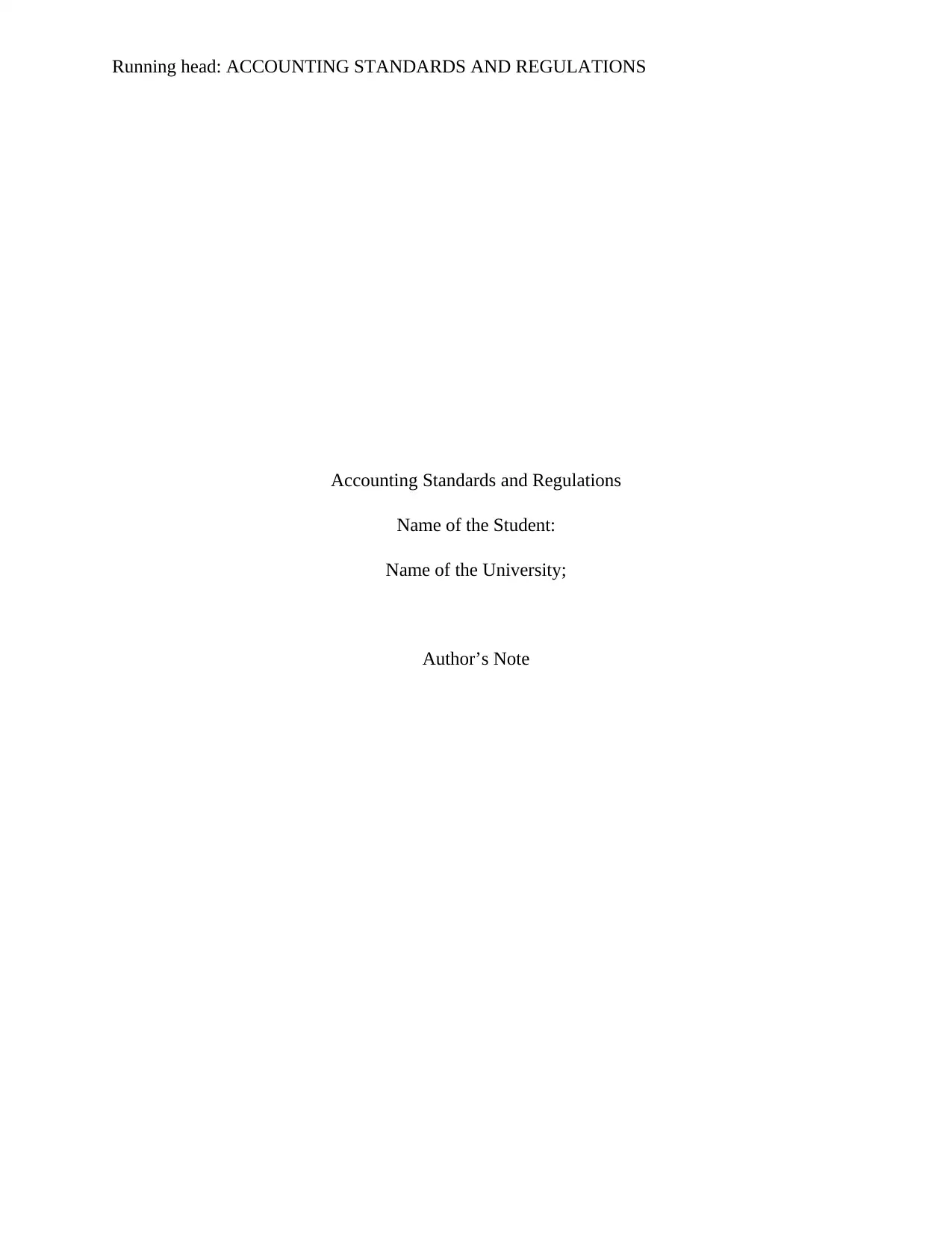
Running head: ACCOUNTING STANDARDS AND REGULATIONS
Accounting Standards and Regulations
Name of the Student:
Name of the University;
Author’s Note
Accounting Standards and Regulations
Name of the Student:
Name of the University;
Author’s Note
Paraphrase This Document
Need a fresh take? Get an instant paraphrase of this document with our AI Paraphraser
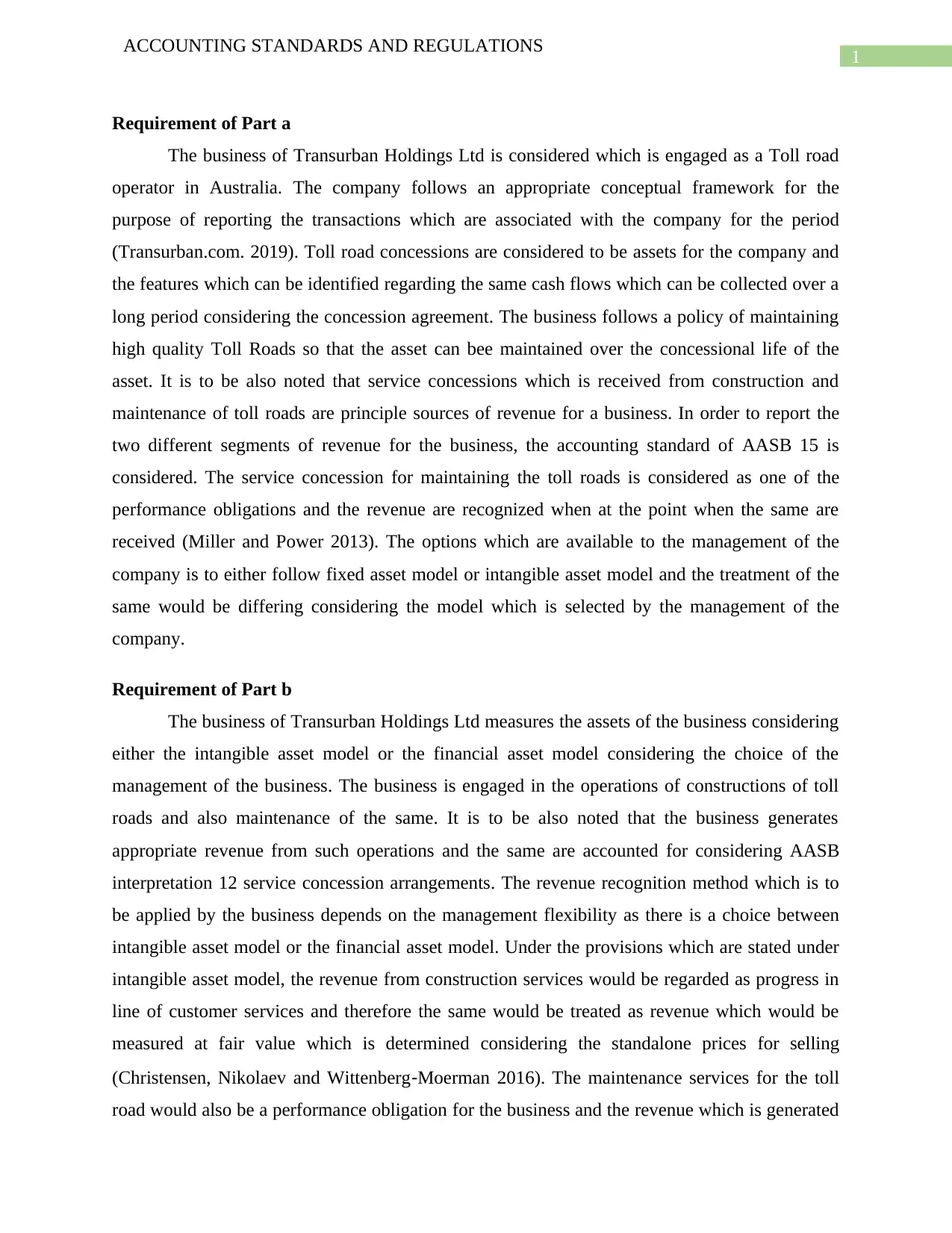
1
ACCOUNTING STANDARDS AND REGULATIONS
Requirement of Part a
The business of Transurban Holdings Ltd is considered which is engaged as a Toll road
operator in Australia. The company follows an appropriate conceptual framework for the
purpose of reporting the transactions which are associated with the company for the period
(Transurban.com. 2019). Toll road concessions are considered to be assets for the company and
the features which can be identified regarding the same cash flows which can be collected over a
long period considering the concession agreement. The business follows a policy of maintaining
high quality Toll Roads so that the asset can bee maintained over the concessional life of the
asset. It is to be also noted that service concessions which is received from construction and
maintenance of toll roads are principle sources of revenue for a business. In order to report the
two different segments of revenue for the business, the accounting standard of AASB 15 is
considered. The service concession for maintaining the toll roads is considered as one of the
performance obligations and the revenue are recognized when at the point when the same are
received (Miller and Power 2013). The options which are available to the management of the
company is to either follow fixed asset model or intangible asset model and the treatment of the
same would be differing considering the model which is selected by the management of the
company.
Requirement of Part b
The business of Transurban Holdings Ltd measures the assets of the business considering
either the intangible asset model or the financial asset model considering the choice of the
management of the business. The business is engaged in the operations of constructions of toll
roads and also maintenance of the same. It is to be also noted that the business generates
appropriate revenue from such operations and the same are accounted for considering AASB
interpretation 12 service concession arrangements. The revenue recognition method which is to
be applied by the business depends on the management flexibility as there is a choice between
intangible asset model or the financial asset model. Under the provisions which are stated under
intangible asset model, the revenue from construction services would be regarded as progress in
line of customer services and therefore the same would be treated as revenue which would be
measured at fair value which is determined considering the standalone prices for selling
(Christensen, Nikolaev and Wittenberg‐Moerman 2016). The maintenance services for the toll
road would also be a performance obligation for the business and the revenue which is generated
ACCOUNTING STANDARDS AND REGULATIONS
Requirement of Part a
The business of Transurban Holdings Ltd is considered which is engaged as a Toll road
operator in Australia. The company follows an appropriate conceptual framework for the
purpose of reporting the transactions which are associated with the company for the period
(Transurban.com. 2019). Toll road concessions are considered to be assets for the company and
the features which can be identified regarding the same cash flows which can be collected over a
long period considering the concession agreement. The business follows a policy of maintaining
high quality Toll Roads so that the asset can bee maintained over the concessional life of the
asset. It is to be also noted that service concessions which is received from construction and
maintenance of toll roads are principle sources of revenue for a business. In order to report the
two different segments of revenue for the business, the accounting standard of AASB 15 is
considered. The service concession for maintaining the toll roads is considered as one of the
performance obligations and the revenue are recognized when at the point when the same are
received (Miller and Power 2013). The options which are available to the management of the
company is to either follow fixed asset model or intangible asset model and the treatment of the
same would be differing considering the model which is selected by the management of the
company.
Requirement of Part b
The business of Transurban Holdings Ltd measures the assets of the business considering
either the intangible asset model or the financial asset model considering the choice of the
management of the business. The business is engaged in the operations of constructions of toll
roads and also maintenance of the same. It is to be also noted that the business generates
appropriate revenue from such operations and the same are accounted for considering AASB
interpretation 12 service concession arrangements. The revenue recognition method which is to
be applied by the business depends on the management flexibility as there is a choice between
intangible asset model or the financial asset model. Under the provisions which are stated under
intangible asset model, the revenue from construction services would be regarded as progress in
line of customer services and therefore the same would be treated as revenue which would be
measured at fair value which is determined considering the standalone prices for selling
(Christensen, Nikolaev and Wittenberg‐Moerman 2016). The maintenance services for the toll
road would also be a performance obligation for the business and the revenue which is generated
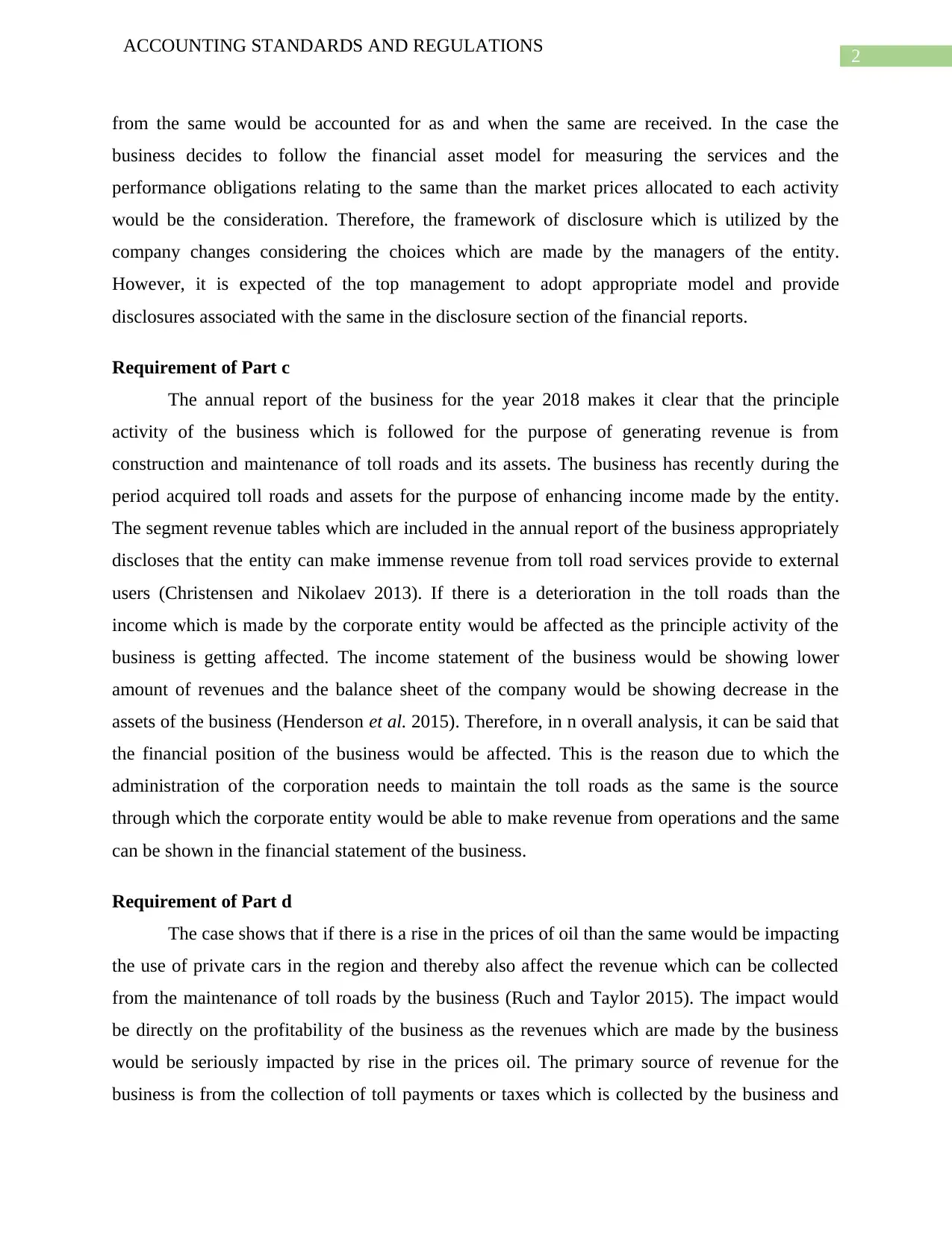
2
ACCOUNTING STANDARDS AND REGULATIONS
from the same would be accounted for as and when the same are received. In the case the
business decides to follow the financial asset model for measuring the services and the
performance obligations relating to the same than the market prices allocated to each activity
would be the consideration. Therefore, the framework of disclosure which is utilized by the
company changes considering the choices which are made by the managers of the entity.
However, it is expected of the top management to adopt appropriate model and provide
disclosures associated with the same in the disclosure section of the financial reports.
Requirement of Part c
The annual report of the business for the year 2018 makes it clear that the principle
activity of the business which is followed for the purpose of generating revenue is from
construction and maintenance of toll roads and its assets. The business has recently during the
period acquired toll roads and assets for the purpose of enhancing income made by the entity.
The segment revenue tables which are included in the annual report of the business appropriately
discloses that the entity can make immense revenue from toll road services provide to external
users (Christensen and Nikolaev 2013). If there is a deterioration in the toll roads than the
income which is made by the corporate entity would be affected as the principle activity of the
business is getting affected. The income statement of the business would be showing lower
amount of revenues and the balance sheet of the company would be showing decrease in the
assets of the business (Henderson et al. 2015). Therefore, in n overall analysis, it can be said that
the financial position of the business would be affected. This is the reason due to which the
administration of the corporation needs to maintain the toll roads as the same is the source
through which the corporate entity would be able to make revenue from operations and the same
can be shown in the financial statement of the business.
Requirement of Part d
The case shows that if there is a rise in the prices of oil than the same would be impacting
the use of private cars in the region and thereby also affect the revenue which can be collected
from the maintenance of toll roads by the business (Ruch and Taylor 2015). The impact would
be directly on the profitability of the business as the revenues which are made by the business
would be seriously impacted by rise in the prices oil. The primary source of revenue for the
business is from the collection of toll payments or taxes which is collected by the business and
ACCOUNTING STANDARDS AND REGULATIONS
from the same would be accounted for as and when the same are received. In the case the
business decides to follow the financial asset model for measuring the services and the
performance obligations relating to the same than the market prices allocated to each activity
would be the consideration. Therefore, the framework of disclosure which is utilized by the
company changes considering the choices which are made by the managers of the entity.
However, it is expected of the top management to adopt appropriate model and provide
disclosures associated with the same in the disclosure section of the financial reports.
Requirement of Part c
The annual report of the business for the year 2018 makes it clear that the principle
activity of the business which is followed for the purpose of generating revenue is from
construction and maintenance of toll roads and its assets. The business has recently during the
period acquired toll roads and assets for the purpose of enhancing income made by the entity.
The segment revenue tables which are included in the annual report of the business appropriately
discloses that the entity can make immense revenue from toll road services provide to external
users (Christensen and Nikolaev 2013). If there is a deterioration in the toll roads than the
income which is made by the corporate entity would be affected as the principle activity of the
business is getting affected. The income statement of the business would be showing lower
amount of revenues and the balance sheet of the company would be showing decrease in the
assets of the business (Henderson et al. 2015). Therefore, in n overall analysis, it can be said that
the financial position of the business would be affected. This is the reason due to which the
administration of the corporation needs to maintain the toll roads as the same is the source
through which the corporate entity would be able to make revenue from operations and the same
can be shown in the financial statement of the business.
Requirement of Part d
The case shows that if there is a rise in the prices of oil than the same would be impacting
the use of private cars in the region and thereby also affect the revenue which can be collected
from the maintenance of toll roads by the business (Ruch and Taylor 2015). The impact would
be directly on the profitability of the business as the revenues which are made by the business
would be seriously impacted by rise in the prices oil. The primary source of revenue for the
business is from the collection of toll payments or taxes which is collected by the business and
⊘ This is a preview!⊘
Do you want full access?
Subscribe today to unlock all pages.

Trusted by 1+ million students worldwide
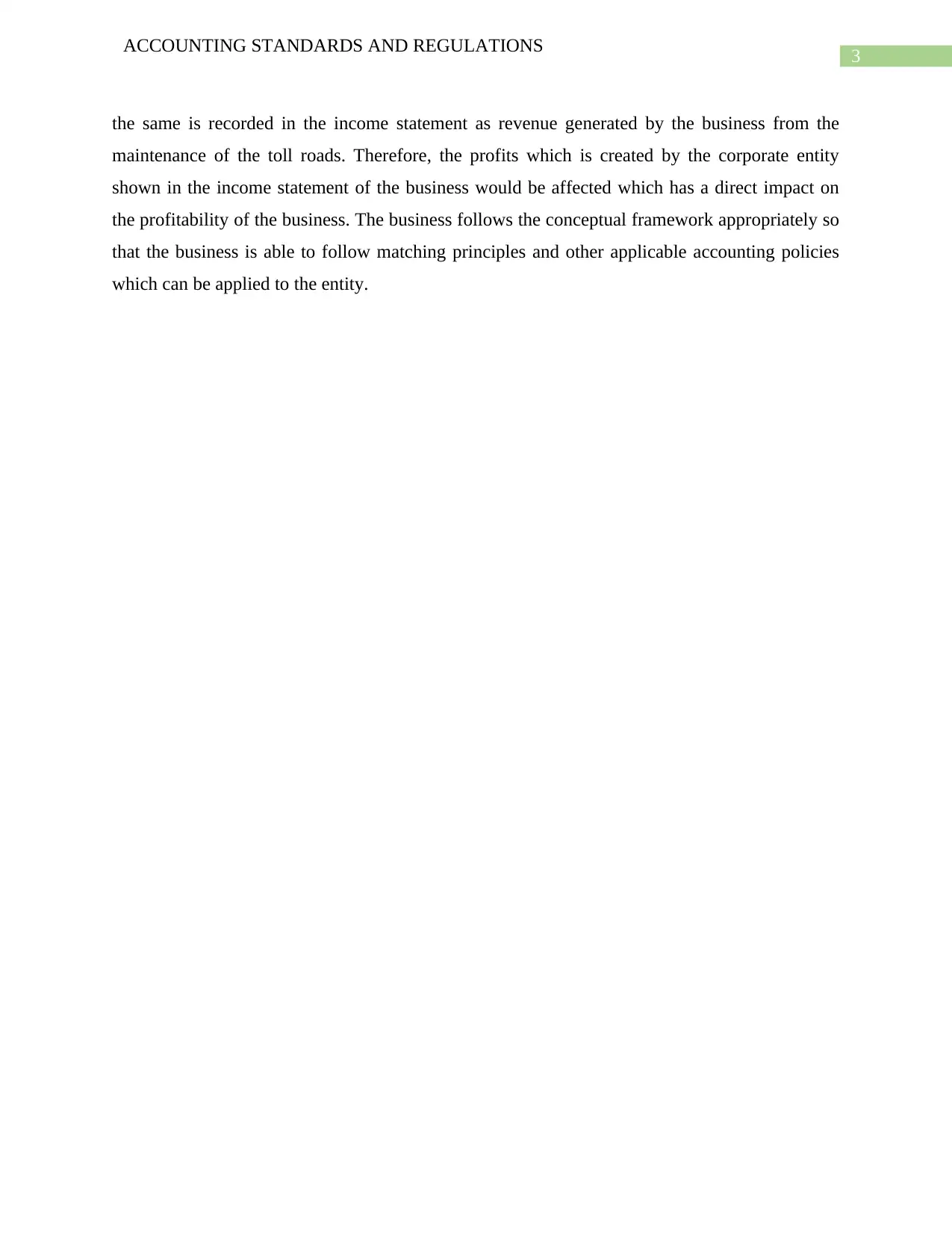
3
ACCOUNTING STANDARDS AND REGULATIONS
the same is recorded in the income statement as revenue generated by the business from the
maintenance of the toll roads. Therefore, the profits which is created by the corporate entity
shown in the income statement of the business would be affected which has a direct impact on
the profitability of the business. The business follows the conceptual framework appropriately so
that the business is able to follow matching principles and other applicable accounting policies
which can be applied to the entity.
ACCOUNTING STANDARDS AND REGULATIONS
the same is recorded in the income statement as revenue generated by the business from the
maintenance of the toll roads. Therefore, the profits which is created by the corporate entity
shown in the income statement of the business would be affected which has a direct impact on
the profitability of the business. The business follows the conceptual framework appropriately so
that the business is able to follow matching principles and other applicable accounting policies
which can be applied to the entity.
Paraphrase This Document
Need a fresh take? Get an instant paraphrase of this document with our AI Paraphraser
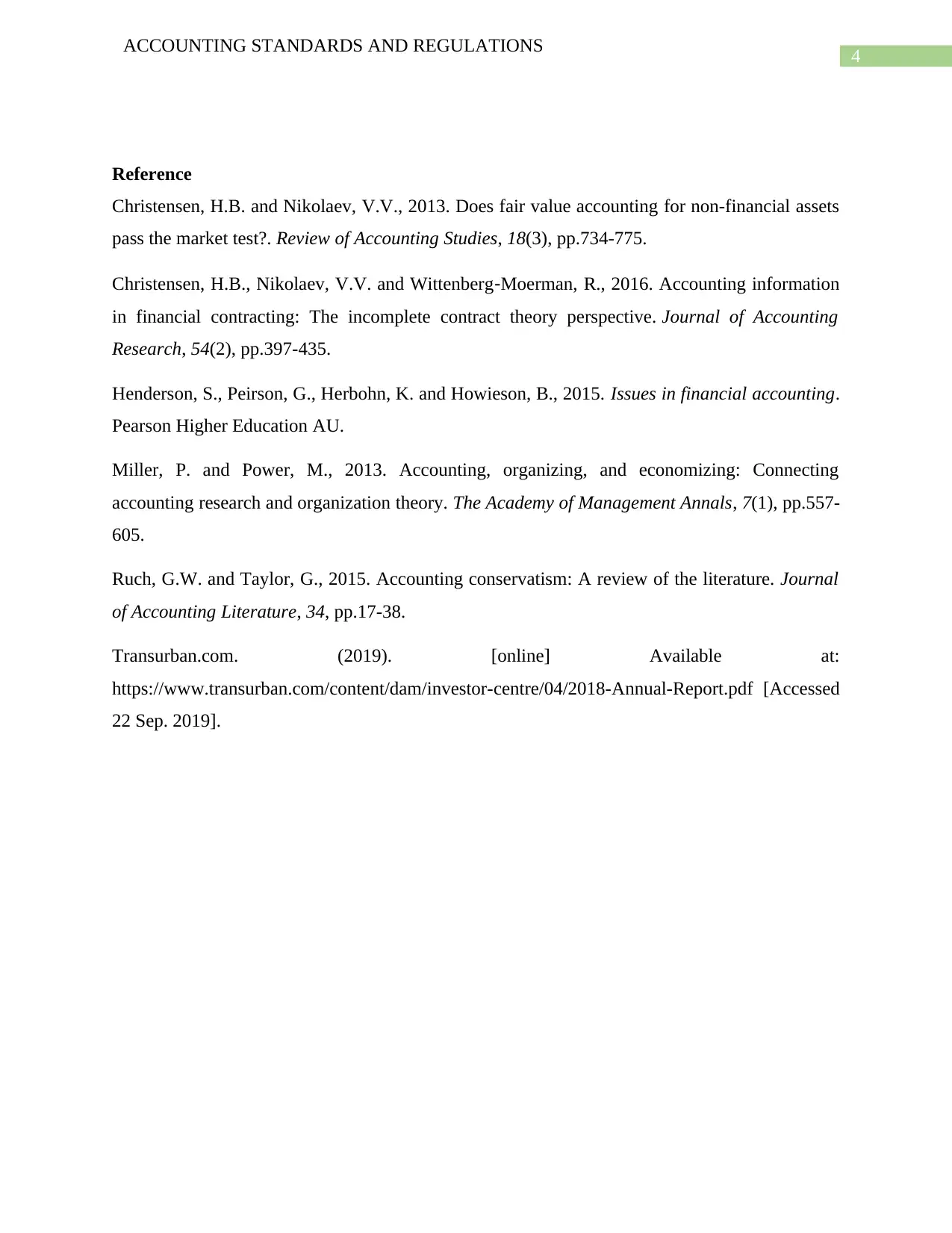
4
ACCOUNTING STANDARDS AND REGULATIONS
Reference
Christensen, H.B. and Nikolaev, V.V., 2013. Does fair value accounting for non-financial assets
pass the market test?. Review of Accounting Studies, 18(3), pp.734-775.
Christensen, H.B., Nikolaev, V.V. and Wittenberg‐Moerman, R., 2016. Accounting information
in financial contracting: The incomplete contract theory perspective. Journal of Accounting
Research, 54(2), pp.397-435.
Henderson, S., Peirson, G., Herbohn, K. and Howieson, B., 2015. Issues in financial accounting.
Pearson Higher Education AU.
Miller, P. and Power, M., 2013. Accounting, organizing, and economizing: Connecting
accounting research and organization theory. The Academy of Management Annals, 7(1), pp.557-
605.
Ruch, G.W. and Taylor, G., 2015. Accounting conservatism: A review of the literature. Journal
of Accounting Literature, 34, pp.17-38.
Transurban.com. (2019). [online] Available at:
https://www.transurban.com/content/dam/investor-centre/04/2018-Annual-Report.pdf [Accessed
22 Sep. 2019].
ACCOUNTING STANDARDS AND REGULATIONS
Reference
Christensen, H.B. and Nikolaev, V.V., 2013. Does fair value accounting for non-financial assets
pass the market test?. Review of Accounting Studies, 18(3), pp.734-775.
Christensen, H.B., Nikolaev, V.V. and Wittenberg‐Moerman, R., 2016. Accounting information
in financial contracting: The incomplete contract theory perspective. Journal of Accounting
Research, 54(2), pp.397-435.
Henderson, S., Peirson, G., Herbohn, K. and Howieson, B., 2015. Issues in financial accounting.
Pearson Higher Education AU.
Miller, P. and Power, M., 2013. Accounting, organizing, and economizing: Connecting
accounting research and organization theory. The Academy of Management Annals, 7(1), pp.557-
605.
Ruch, G.W. and Taylor, G., 2015. Accounting conservatism: A review of the literature. Journal
of Accounting Literature, 34, pp.17-38.
Transurban.com. (2019). [online] Available at:
https://www.transurban.com/content/dam/investor-centre/04/2018-Annual-Report.pdf [Accessed
22 Sep. 2019].
1 out of 5
Related Documents
Your All-in-One AI-Powered Toolkit for Academic Success.
+13062052269
info@desklib.com
Available 24*7 on WhatsApp / Email
![[object Object]](/_next/static/media/star-bottom.7253800d.svg)
Unlock your academic potential
Copyright © 2020–2025 A2Z Services. All Rights Reserved. Developed and managed by ZUCOL.





